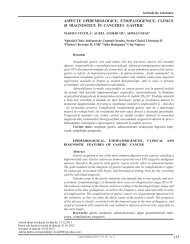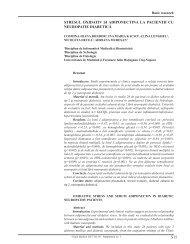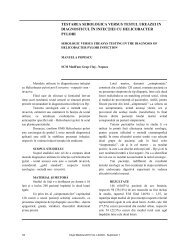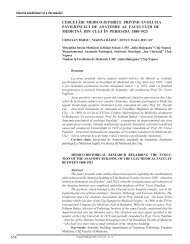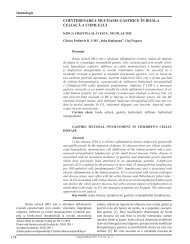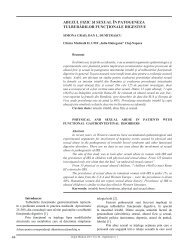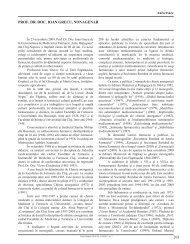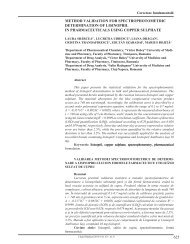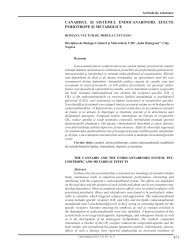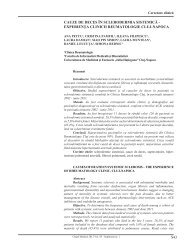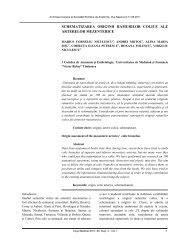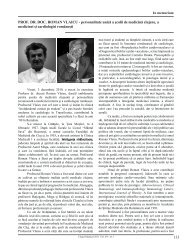RevistÄ de MedicinÄ Åi Farmacie - Clujul Medical - Iuliu HaÅ£ieganu
RevistÄ de MedicinÄ Åi Farmacie - Clujul Medical - Iuliu HaÅ£ieganu
RevistÄ de MedicinÄ Åi Farmacie - Clujul Medical - Iuliu HaÅ£ieganu
You also want an ePaper? Increase the reach of your titles
YUMPU automatically turns print PDFs into web optimized ePapers that Google loves.
Patologie digestivă<br />
time. The orocecal transit time is a good indicator for the<br />
speed of the small intestine passage [19]. Lactulose can be<br />
given with water or mixed into a test meal. Alternatively a<br />
meal which contains a source of unresorbable carbohydrate<br />
such as baked beans can be used instead of lactulose. The<br />
test can be helpful in patients with unexplained diarrhea or<br />
constipation.<br />
progressing from distal to proximal indicate retrogra<strong>de</strong><br />
movement. The clinical value of this new technique is<br />
un<strong>de</strong>r <strong>de</strong>bate. But first results and ongoing studies rise the<br />
expectation that this method could be helpful in functional<br />
dysphagia and in evaluating patients with gastroesophageal<br />
reflux disease and persistent symptoms on proton pump<br />
inhibitor therapy [24]. It seems also to i<strong>de</strong>ntify patients who<br />
may profit best from antireflux surgery [25]. But further<br />
studies must be awaited.<br />
Fig. 7. Measurement of orocecal transit time with the hydrogen<br />
breath test: the diagram illustrates the principle of this technique.<br />
In this case 10 g of lactulose has been mixed to a test meal and<br />
then ingested by the patient. About 6 hours later there is a sud<strong>de</strong>n<br />
rise in the quantity (ppm) of hydrogen (H2) in the exhaled breath.<br />
This is the time when the lactulose arrives in the cecum.<br />
Fig. 8. Impedance measurement: This diagram illustrates<br />
the principle of impedance measurement: a bolus with a high<br />
conductivity (many ions) is passing the impedance ring set<br />
mounted on a catheter. As a consequence impedance between the<br />
two rings will be lowered. When the bolus has passed the ring set<br />
impedance will increase again.<br />
Pellet tests (radiology)<br />
As already mentioned radio-opaque pellets can<br />
be used for assessing colonic transit time or gastric<br />
emptying.<br />
Impedance measurement<br />
Impedance have long be established for monitoring<br />
the volume of various organs. The current frequency used<br />
does not influence sensitive neuronal synapses. Impedance<br />
measurement was used for non-invasive gastric emptying<br />
studies [20]. Multichannel impedance is a new technique<br />
<strong>de</strong>signed to <strong>de</strong>tect intraluminal bolus movement [21-23].<br />
The principle is based on measurement of changes in<br />
resistance to alternating electrical current when a bolus<br />
passes by a pair of metallic rings mounted on a catheter.<br />
Liquid boluses contain an increased number of ions<br />
exhibiting a higher conductivity. Thus they will lower the<br />
impedance. The impedance stays at its nadir as long as the<br />
bolus is present in the segment, returning to baseline once<br />
the bolus is cleared by a contraction (Fig. 8). In contrast gas<br />
will show a high impedance. In consequence gas passing<br />
will produce a transient rapid rise in the impedance since<br />
it has a poor electrical conductance. The direction of bolus<br />
movement can be seen by temporal differences in bolus<br />
entry and exit. A bolus progressing from proximal to distal<br />
indicates an antegra<strong>de</strong> movement whereas bolus entries<br />
Conclusions<br />
For direct and indirect measurements of<br />
gastrointestinal motility various techniques and methods<br />
are available. In clinical practice the physician has to<br />
choose the best test or combination of tests sufficiently<br />
specific and effective to analyze and i<strong>de</strong>ntify the supposed<br />
individual motor disor<strong>de</strong>r of the gastrointestinal tract. The<br />
current available motility tests have clear limitations and<br />
our knowledge about physiology and pathophysiology of<br />
gastrointestinal motility is incomplete. But this should not<br />
<strong>de</strong>moralize us. Advances in available instrumentarium,<br />
increase of our knowledge about gastrointestinal motility<br />
in health and disease and <strong>de</strong>velopment of new gut-selective<br />
drugs will make our diagnoses more precise and our<br />
treatment more specific and effective. We always should<br />
remember the sentence N.W. Read wrote in 1989 (26):<br />
Science is never cast in stone, and i<strong>de</strong>as are written with a<br />
finger on shifting sand.<br />
Measuring GI motility is still a challenge of the<br />
gastroenterologist [27].<br />
Aklnowledgments: This paper is based on a lecture given at<br />
the 2 nd International Symposium of Neurogastroenterology<br />
and a version of it was published in the proceedings;<br />
reprinted with the permission of the editor.<br />
318<br />
<strong>Clujul</strong> <strong>Medical</strong> 2009 Vol. LXXXII - nr. 3



